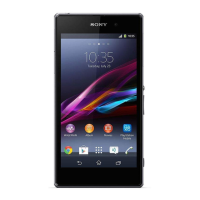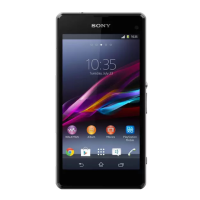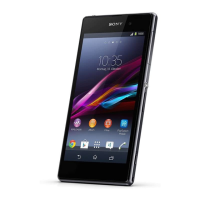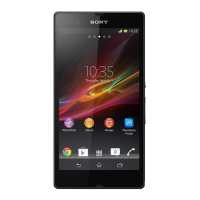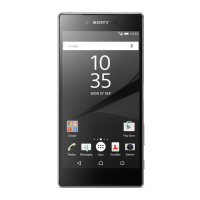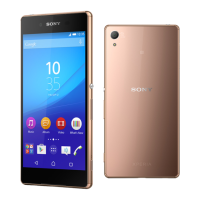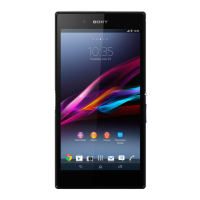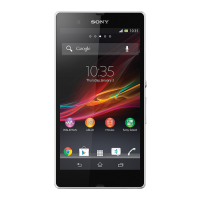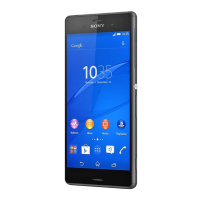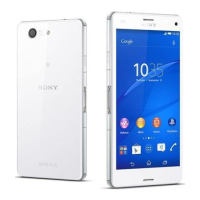Do you have a question about the Sony Xperia Z1 Compact and is the answer not in the manual?
Details about the content and scope of the user guide for the device.
Identifies key external and internal components of the device.
Instructions for initial physical setup, including SIM and memory card insertion.
Guide to the initial setup process, including configuration and account setup.
Explains the benefits and necessity of a Google account for device features.
Instructions on how to connect the device to a power source for charging.
Details on how to set up and manage different user profiles on the device.
Describes fundamental touchscreen gestures like tapping and holding.
Explains how to secure and access the device's display.
Introduces the device's main interface and navigation.
Details on accessing and managing installed applications.
How to move between and manage active applications.
Information on using miniature applications for multitasking.
How to add, resize, and manage widgets on the home screen.
Methods for organizing applications and creating shortcuts.
Customizing the device's appearance with wallpapers and themes.
Instructions on capturing images of the device screen.
Guide to capturing video of the device's screen activity.
How to view and manage alerts and status updates.
Explanation of the various icons displayed in the device's status bar.
Steps to find and install apps from the official Google Play Store.
Guidance on enabling and installing apps from outside Google Play.
How to use the built-in web browser for internet access.
Configuration for mobile data and multimedia messaging services.
Instructions for connecting to and managing Wi-Fi networks.
Methods to use the device as a hotspot or share data via USB/Bluetooth.
Monitoring and managing mobile data consumption to avoid charges.
How to choose between different mobile network types and operators.
Steps for setting up and connecting to secure VPNs.
How to sync contacts, email, and calendar with online services.
Setting up and managing corporate email accounts.
Transferring contacts and calendar data via PC Companion or Sony Bridge.
Methods to open the device settings menu.
Adjusting audio levels, ringtones, and notification sounds.
Controlling how and when notifications are received and displayed.
Setting up a PIN to lock or unlock the SIM card.
Locking the screen to a specific application.
Activating and configuring the interactive screen saver.
Setting up security measures like PIN, pattern, or password.
Changing the device's display language and input language.
Manually setting or automatically updating the date and time.
Information on the display enhancement technology.
Adjusting audio settings for better sound quality.
Using the virtual keyboard for text input.
Using the 12-key telephone keypad for text input.
Utilizing voice recognition for text input.
Features for selecting, cutting, copying, and pasting text.
Customizing keyboard settings like languages and word suggestions.
Methods for initiating phone calls.
How to answer or reject incoming calls.
Setting up and managing voicemail features.
Managing active calls, including hold and speakerphone.
Viewing missed, received, and dialled call history.
Redirecting incoming calls to another number or service.
Blocking specific incoming or outgoing calls.
Handling multiple active calls simultaneously.
Setting up and managing group calls.
Accessing and managing voicemail messages.
Making emergency calls, even without a SIM card.
Methods for moving contacts from old devices or accounts.
Locating and accessing contact information.
Creating new contacts and modifying existing ones.
Inputting ICE information for emergency access.
Organizing contacts for quicker access.
Sharing contact details via various methods.
Managing duplicate contact information.
Methods for saving contact data for safekeeping.
How to compose, send, and read text and multimedia messages.
Managing conversations, deleting messages, and starring important ones.
Initiating calls directly from message conversations.
Configuring message notification sounds and delivery reports.
Using Hangouts™ for real-time communication.
Steps to configure email accounts on the device.
How to manage email inboxes and compose messages.
Sorting, searching, and managing email content.
Managing account details and inbox check frequency.
Using the Gmail application for email.
Methods to move music files from a computer to the device.
Using the Walkman® application to play music.
Creating, playing, and managing music playlists.
Methods to share songs, albums, or playlists with others.
Adjusting audio settings like Equalizer and Surround sound.
Applying visual effects to music playback.
Using the service to identify songs playing nearby.
How to tune into and listen to FM radio stations.
Saving and managing preferred radio channels.
Adjusting mono/stereo modes and radio region.
Basic operations for capturing images and videos.
Using the camera feature to automatically focus on faces.
Automatically taking photos when a smile is detected.
Enabling geotagging to tag photos with location data.
Overview of various camera capturing modes and settings.
Configuring settings specific to video recording.
Combining images from multiple devices for a single photo.
Steps to find and install additional camera apps.
Configuring the camera to launch quickly from the lock screen.
Detailed settings for still photography.
Using the timer for delayed photo or video capture.
Adjusting focus settings for sharp images.
Using High Dynamic Range for challenging lighting conditions.
Adjusting ISO sensitivity to control image noise.
Setting exposure balance based on light conditions.
Using stabilization to reduce camera shake.
Configuring how photos/videos are previewed after capture.
Registering faces for automatic focus.
Using the flash for various lighting conditions.
Using pre-programmed scenes for optimal photo settings.
Navigating and viewing media files within the Album application.
Methods for sharing and organizing media files.
Applying edits and effects to photos.
Creating and editing short videos from existing media.
Securing media files by moving them to a hidden folder.
Navigating the Album application's main menu.
Displaying geotagged photos on a map interface.
Playing downloaded or saved video content.
Methods to move video files onto the device.
Finding, clearing, and deleting video information.
Automatically creating short videos from photos and videos.
Accessing and using the video rental and purchase service.
Connecting the device to a TV via MHL or HDMI cable.
Using Wi-Fi Direct™ to display device content on a TV.
Streaming media content to DLNA-compatible devices.
Using Near Field Communication for data sharing and connections.
Connecting and transferring data with Bluetooth devices.
Automatically configuring features using NFC.
Automating actions based on accessory connection or time.
Connecting with ANT+™ enabled fitness devices.
Making payments using NFC and installed payment services.
Enabling and configuring location services for apps.
Using Google Maps for location tracking and directions.
Activating data roaming for internet access abroad.
Connecting the device to car systems via USB for MirrorLink™.
Disabling wireless radios to prevent interference.
Managing schedules, creating events, and viewing calendars.
Setting and managing alarms, timers, and the clock.
Accessing help, troubleshooting guides, and software update info.
Software for connecting the device to a computer.
Instructions for installing software updates.
Using my Xperia service to locate and secure a lost device.
Monitoring battery usage and optimizing power consumption.
Understanding internal storage, memory cards, and RAM.
Transferring and managing files between device and computer.
Saving and retrieving device data.
Performing tests to check device functionality.
Force restarting or factory resetting the device.
Guidelines for device usage in various environmental conditions.
Explanation of the device's water and dust resistance ratings.
Details about the content and scope of the user guide for the device.
Identifies key external and internal components of the device.
Instructions for initial physical setup, including SIM and memory card insertion.
Guide to the initial setup process, including configuration and account setup.
Explains the benefits and necessity of a Google account for device features.
Instructions on how to connect the device to a power source for charging.
Details on how to set up and manage different user profiles on the device.
Describes fundamental touchscreen gestures like tapping and holding.
Explains how to secure and access the device's display.
Introduces the device's main interface and navigation.
Details on accessing and managing installed applications.
How to move between and manage active applications.
Information on using miniature applications for multitasking.
How to add, resize, and manage widgets on the home screen.
Methods for organizing applications and creating shortcuts.
Customizing the device's appearance with wallpapers and themes.
Instructions on capturing images of the device screen.
Guide to capturing video of the device's screen activity.
How to view and manage alerts and status updates.
Explanation of the various icons displayed in the device's status bar.
Steps to find and install apps from the official Google Play Store.
Guidance on enabling and installing apps from outside Google Play.
How to use the built-in web browser for internet access.
Configuration for mobile data and multimedia messaging services.
Instructions for connecting to and managing Wi-Fi networks.
Methods to use the device as a hotspot or share data via USB/Bluetooth.
Monitoring and managing mobile data consumption to avoid charges.
How to choose between different mobile network types and operators.
Steps for setting up and connecting to secure VPNs.
How to sync contacts, email, and calendar with online services.
Setting up and managing corporate email accounts.
Transferring contacts and calendar data via PC Companion or Sony Bridge.
Methods to open the device settings menu.
Adjusting audio levels, ringtones, and notification sounds.
Controlling how and when notifications are received and displayed.
Setting up a PIN to lock or unlock the SIM card.
Locking the screen to a specific application.
Activating and configuring the interactive screen saver.
Setting up security measures like PIN, pattern, or password.
Changing the device's display language and input language.
Manually setting or automatically updating the date and time.
Information on the display enhancement technology.
Adjusting audio settings for better sound quality.
Using the virtual keyboard for text input.
Using the 12-key telephone keypad for text input.
Utilizing voice recognition for text input.
Features for selecting, cutting, copying, and pasting text.
Customizing keyboard settings like languages and word suggestions.
Methods for initiating phone calls.
How to answer or reject incoming calls.
Setting up and managing voicemail features.
Managing active calls, including hold and speakerphone.
Viewing missed, received, and dialled call history.
Redirecting incoming calls to another number or service.
Blocking specific incoming or outgoing calls.
Handling multiple active calls simultaneously.
Setting up and managing group calls.
Accessing and managing voicemail messages.
Making emergency calls, even without a SIM card.
Methods for moving contacts from old devices or accounts.
Locating and accessing contact information.
Creating new contacts and modifying existing ones.
Inputting ICE information for emergency access.
Organizing contacts for quicker access.
Sharing contact details via various methods.
Managing duplicate contact information.
Methods for saving contact data for safekeeping.
How to compose, send, and read text and multimedia messages.
Managing conversations, deleting messages, and starring important ones.
Initiating calls directly from message conversations.
Configuring message notification sounds and delivery reports.
Using Hangouts™ for real-time communication.
Steps to configure email accounts on the device.
How to manage email inboxes and compose messages.
Sorting, searching, and managing email content.
Managing account details and inbox check frequency.
Using the Gmail application for email.
Methods to move music files from a computer to the device.
Using the Walkman® application to play music.
Creating, playing, and managing music playlists.
Methods to share songs, albums, or playlists with others.
Adjusting audio settings like Equalizer and Surround sound.
Applying visual effects to music playback.
Using the service to identify songs playing nearby.
How to tune into and listen to FM radio stations.
Saving and managing preferred radio channels.
Adjusting mono/stereo modes and radio region.
Basic operations for capturing images and videos.
Using the camera feature to automatically focus on faces.
Automatically taking photos when a smile is detected.
Enabling geotagging to tag photos with location data.
Overview of various camera capturing modes and settings.
Configuring settings specific to video recording.
Combining images from multiple devices for a single photo.
Steps to find and install additional camera apps.
Configuring the camera to launch quickly from the lock screen.
Detailed settings for still photography.
Using the timer for delayed photo or video capture.
Adjusting focus settings for sharp images.
Using High Dynamic Range for challenging lighting conditions.
Adjusting ISO sensitivity to control image noise.
Setting exposure balance based on light conditions.
Using stabilization to reduce camera shake.
Configuring how photos/videos are previewed after capture.
Registering faces for automatic focus.
Using the flash for various lighting conditions.
Using pre-programmed scenes for optimal photo settings.
Navigating and viewing media files within the Album application.
Methods for sharing and organizing media files.
Applying edits and effects to photos.
Creating and editing short videos from existing media.
Securing media files by moving them to a hidden folder.
Navigating the Album application's main menu.
Displaying geotagged photos on a map interface.
Playing downloaded or saved video content.
Methods to move video files onto the device.
Finding, clearing, and deleting video information.
Automatically creating short videos from photos and videos.
Accessing and using the video rental and purchase service.
Connecting the device to a TV via MHL or HDMI cable.
Using Wi-Fi Direct™ to display device content on a TV.
Streaming media content to DLNA-compatible devices.
Using Near Field Communication for data sharing and connections.
Connecting and transferring data with Bluetooth devices.
Automatically configuring features using NFC.
Automating actions based on accessory connection or time.
Connecting with ANT+™ enabled fitness devices.
Making payments using NFC and installed payment services.
Enabling and configuring location services for apps.
Using Google Maps for location tracking and directions.
Activating data roaming for internet access abroad.
Connecting the device to car systems via USB for MirrorLink™.
Disabling wireless radios to prevent interference.
Managing schedules, creating events, and viewing calendars.
Setting and managing alarms, timers, and the clock.
Accessing help, troubleshooting guides, and software update info.
Software for connecting the device to a computer.
Instructions for installing software updates.
Using my Xperia service to locate and secure a lost device.
Monitoring battery usage and optimizing power consumption.
Understanding internal storage, memory cards, and RAM.
Transferring and managing files between device and computer.
Saving and retrieving device data.
Performing tests to check device functionality.
Force restarting or factory resetting the device.
Guidelines for device usage in various environmental conditions.
Explanation of the device's water and dust resistance ratings.
| RAM | 2 GB |
|---|---|
| Internal Storage | 16 GB |
| Main Camera | 20.7 MP |
| Selfie Camera | 2 MP |
| Battery | 2300 mAh |
| Operating System | Android 4.3 (Jelly Bean), upgradable to 5.1 (Lollipop) |
| Dimensions | 127 x 64.9 x 9.5 mm (5.0 x 2.56 x 0.37 in) |
| Weight | 137 g (4.83 oz) |
| SIM | Micro-SIM |
| Video | 1080p@30fps |
| Loudspeaker | Yes |
| 3.5mm Jack | Yes |
| Bluetooth | 4.0, A2DP, aptX |
| GPS | Yes, with A-GPS, GLONASS |
| NFC | Yes |
| Radio | FM radio with RDS |
| USB | microUSB 2.0 (MHL TV-out) |
| Sensors | Accelerometer, gyro, proximity, compass |
| Colors | Black, White, Pink, Lime |
| Display | 4.3 inches, 720 x 1280 pixels |
| Processor | Qualcomm MSM8974 Snapdragon 800 |
| Water Resistance | IP58 dust/water resistant (over 1.5 meter and 30 minutes) |
| Card Slot | microSD (dedicated slot) |
| WLAN | Wi-Fi 802.11 a/b/g/n, dual-band, DLNA, hotspot |
